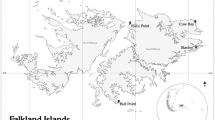Abstract
Eggs, feathers (down, body feathers from side/shoulder and back) and some dead chicks (liver) from broods of three species, herring gull (Larus argentatus), black-headed gull (Larus ridibundus), and common tern (Sterna hirundo) from the German North Sea coast were collected to study intersibling differences in mercury contamination and elimination into the growing feathers. The mercury contamination in eggs, feathers, and liver of the terns was about four times that of the gulls; black-headed gulls had lowest mercury concentrations. The body feathers grown when the chicks became older had lower mercury levels than down in the more contaminated species (11% lower in herring gulls, 49% in common terns), indicating the advancing decontamination of the body by the plumage development. The elimination of mercury was greater in chicks with higher mercury levels. Down of the first hatched herring gull and common tern chick contained more mercury than down of the siblings hatched later, because of its higher burden derived from the first laid egg.
Similar content being viewed by others
References
Bäckström J (1969) Distribution studies of mercuric pesticides in quail and some fresh-water fishes. Acta Pharmacol Toxicol 27:1–103
Becker PH (1989) Seabirds as monitor organisms of contaminants along the German North Sea coast. Helgoländer Meeresunters 43:395–403
— (1992) Egg mercury levels decline with the laying sequence in Charadriiformes. Bull Environ Contam Toxicol 48:162–167
Becker PH, Finck P (1985) Witterung und Ernährungssituation als entscheidende Faktoren des Bruterfolgs der Flußseeschwalbe (Sterna hirundo). J Ornithol 126:393–404
Becker PH, Frank D, Walter U (1987) Geographische und jährliche Variation der Ernährung der Flußseeschwalbe (Sterna hirundo) an der Nordseeküste. J Ornithol 128:457–475
Becker PH, Furness RW, Henning D (1993a) Mercury dynamics in young common tern (Sterna hirundo) chicks from a polluted environment. Ecotoxicology 2:33–40
--, --, -- (1993b) The value of chick feathers to assess spatial and interspecific variation in the mercury contamination of seabirds. Environ Monitor Assess:255–262
Becker PH, Sperveslage H (1989) Organochlorines and heavy metals in Herring Gull, Larus argentatus, eggs and chicks from the same clutch. Bull Environ Contam Toxicol 42:721–727
Becker PH, Ternes W, Rüssel HA (1985) Schadstoffe in Gelegen von Brutvögeln der deutschen Nordseeküste. II. Quecksilber. J Ornithol 126:253–262
Braune BM (1987) Comparison of total mercury levels in relation to diet and molt for nine species of marine birds. Arch Environ Contam Toxicol 16:217–224
Braune BM, Gaskin DE (1987a) A mercury budget for the Bonaparte's Gull during autumn moult. Ornis Scand 18:244–250
—, — (1987b) Mercury levels in Bonaparte's Gulls (Larus philadelphia) during autumn moult in the Quoddy region, New Brunswick, Canada. Arch Environ Contam Toxicol 16:539–549
Burger J, Gochfeld M (1992) Trace element distribution in growing feathers: Additional excretion in feather sheaths. Arch Environ Contam Toxicol 23:105–108
Furness RW, Muirhead SJ, Woodburn M (1986) Using bird feathers to measure mercury in the environment: Relationships between mercury content and moult. Mar Pollut Bull 17:27–30
Furness RW, Thompson DR, Becker PH (1994) Spatial and temporal variation in mercury contamination of seabirds in the North Sea. Helgoländer Meeresunters (in press)
Gorke M (1990) Die Lachmöwe (Larus ridibundus) in Wattenmeer und Binnenland. Seevögel 11/Sonderheft:1–48
Honda K, Naus T, Tatsukawa R (1986) Seasonal changes in mercury accumulation in the black-eared Kite, Milvus migrans lineatus. Environ Pollut (A) 42:325–334
Leonzio C, Fossi C, Focardi S (1986) Lead, mercury, cadmium and selenium in two species of gull feeding on intend dumps, and in marine areas. Sci Total Environ 57:121–127
Lewis SA (1991) Studies of mercury dynamics in birds. PhD thesis, University of Glasgow, Scotland, UK
Lewis SA, Furness RW (1991) Mercury accumulation and excretion in laboratory reared Black-headed Gull Larus ridibundus chicks. Arch Environ Contam Toxicol 21:316–320
Lewis SA, Becker PH, Furness RW (1993) Mercury levels in eggs, internal tissues and feathers of Herring Gulls Larus argentatus from the German Wadden Sea. Environ Pollut 80:293–299
Noordhuis R, Spaans L (1992) Interspecific competition for food between herring Larus argentatus and lesser black-backed gulls L. fuscus in the Dutch Wadden Sea area. Ardea 80:115–132
Scheuhammer AM (1987) The chronic toxicity of aluminum, cadmium, mercury and lead in birds: A review. Environ Pollut 46:263–295
Sydeman WJ, Emslie SD (1992) Effects of parental age on hatching asynchrony, egg size and third-chick disadvantage in Western Gulls. Auk 109:242–248
Thompson DR, Furness RW (1989) Comparison of the levels of total and organic mercury in seabird feathers. Mar Pollut Bull 20:577–579
Author information
Authors and Affiliations
Rights and permissions
About this article
Cite this article
Becker, P.H., Henning, D. & Furness, R.W. Differences in mercury contamination and elimination during feather development in gull and tern broods. Arch. Environ. Contam. Toxicol. 27, 162–167 (1994). https://doi.org/10.1007/BF00214258
Received:
Revised:
Issue Date:
DOI: https://doi.org/10.1007/BF00214258




